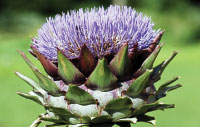
Features
Production
Vegetables
Intrepid farmer growing artichokes usually imported from California
April 23, 2008 By Jennifer Bain
Intrepid farmer growing artichokes usually imported from California
 |
| An example of a globe artichoke plant in flower. |
Some would say Dominic DeFilippis is perfectly suited to experimenting with artichoke crops in Ontario.
He was born in the province but claims Italian heritage. That’s important because Italians love artichokes. These days it’s not always enough for farmers to simply grow something. They need to convince people to buy it by raving about how great it tastes and offering cooking tips.
Besides, DeFilippis’ family has been farming here for 47 years – 44 of those in Markham, Ont. And although his farm specializes in broccoli, cauliflower and cabbage, DeFilippis is one of those high-energy guys who loves – no, needs – to dabble in challenging side projects.
“I know artichokes and I know how people eat them,” he said during a recent farm tour.
In 2005, he had a 0.2-hectare plot that did well. In 2006 a two-hectare plot wasn’t successful and he toyed with giving up but decided to give the crop one more shot.
“It looks like whatever we did, we did it right. (During 2007) the yield (was) tremendous.”
Top Tomato Foods harvested two hec-tares of globe artichokes this past fall. Just 60 to 115 grams apiece, they were snapped up at the Ontario Food Terminal by a dozen or so independent retailers, including Longo’s, Highland Farms, Michael-Angelo’s and Pusateri’s Fine Foods.
It’s a treat to have a homegrown version of something that can usually only be imported from California. But there’s a problem attached to the food – artichokes seem like a lot of hassle.
Let’s demystify this under-appreciated vegetable.
Artichokes are the immature flower bud of a thistle plant that’s native to the Mediterranean and now cultivated in Italy, Spain, France and California.
Artichokes grow on a plant (that can be perennial or annual) that’s about half a metre to 1.5 metres high. One plant might produce 12 to 36 artichokes on its multiple branches. The base of the leaves and the heart of the bud (but not always the fuzzy choke) are edible prior to flowering.
On the nutrition front, the California Artichoke Advisory Board reports this vegetable is high in potassium and contains vitamin C, fibre, folate and magnesium. Artichokes also contain cynarin, which stimulates taste buds to make things some people eat and drink immediately afterward taste sweet.
Artichoke recipes aren’t exactly plentiful. Many North American based recipes call for jarred, marinated artichoke hearts, but Greek, Italian and Spanish cookbooks prefer to work with the fresh version.
Consumers can boil or steam artichokes whole or trimmed so only the tender inner leaves and hearts remain. Barbecuing and deep-frying are becoming popular alternatives. (An artichoke festival in Castroville, Calif., held each May sells artichokes every which way.)
DeFilippis, 51, whose family hails from Italy’s Bari province, likes his artichokes heavily trimmed. “Our part of Italy totally throws the leaves in the garbage,” he says.
How many artichokes does this close-knit farm family eat each day?
“Five to 10,” jokes son Vito, 25, the farm’s general manager. “Isn’t that the rule – five to 10 artichokes a day?” (Another son, Antony, 19, is also a general manager and handles marketing. Both help with the on-site farm stand.)
The DeFilippis only farm them as an annual crop on two out of 263 hectares.
During the 2007 season, the seeds were planted in the greenhouse March 28 and transplanted to the field May 21. Harvest (cutting artichokes from the stalk by hand with a knife) began mid-August and continued until frost hit.
Ontario-grown artichokes – which are the Imperial Star variety – shouldn’t have to compete with American ones. The best California artichokes, says DeFilippis, arrive here in winter and spring, while inferior ones (often heat-stressed and tough) show up at other times.
Not only is the family experimenting with growing artichokes, they’ve also been trying to figure out how to package them. For now they’re packed in two layers in six-litre flat boxes used for strawberries. They need to be kept cold and wet, so stores are encouraged to only put a few out front.
A good artichoke should be heavy with tightly packed green leaves. Inside should be pale yellow. If the internal leaves are red, pink or purple, expect them to be tough because of heat stress or lack of water.
“We don’t want people to say, ‘My God, the artichokes that Dom’s growing are tough,’ so we throw those ones out,” says DeFilippis. “We want to get Ontario artichokes on a roll.”
Mike Columbus, new crop specialist of the Ontario Ministry of Agriculture, Food and Rural Affairs, has been trying to encourage local farmers to experiment with artichokes for several years.
DeFilippis isn’t the first farmer to take on the challenge, but he is the first to have enough success to bring a substantial crop to market.
“It has been a niche market – an ethnic crop,” says Columbus.
“A lot of people have heard of artichokes, seen them in stores, but don’t know how to prepare and use them. When they do try them, they really like them.”
Article courtesy The Canadian Press
Print this page